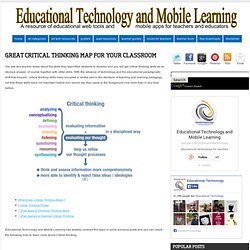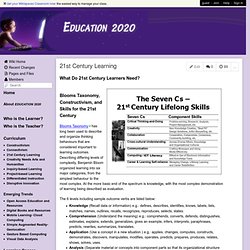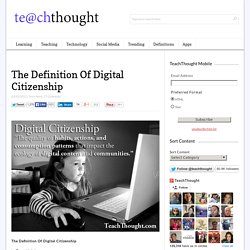

Educational Technology and Mobile Learning: Great Critical Thinking Map for your Classroom. You ask any teacher today about the skills they want their students to develop and you will get critical thinking skills as an obvious answer; of course together with other skills.

With the advance of technology and the educational paradigmatic shift that ensued , critical thinking skills have occupied a central part in the literature of teaching and learning pedagogy, not that these skills were not important before but I would say they came to the foreground now more than in any time before. Educational Technology and Mobile Learning has already covered this topic in some previous posts and you can check the following links to learn more about Critical thinking. For today, I am sharing with you a great graphic that illustrates some elements of critical thinking process. שיח על תפקידי המורה במאה ה-21 - יום ג' 11/6 מיומנויות המאה ה-21-גיא לוי. הגדרת מיומנויות המאה ה-21. המאמר משלב בין מחקרים בנושא סטנדרטים והערכה בקידום למידה.

הוא מתאר מערכות הערכה המסייעות ליצירת שינויים בהוראה, ממחיש את השפעת השימוש בטכנולוגיה בתהליכי ההערכה ומציע מודל להערכת מיומנויות המאה ה-21. תהליכי הערכה, מלבד היותם תהליכים המספקים מידע לגיבוש עמדות ולהמשך הוראה, מסייעים להגדיר את מטרות הלמידה. תהליכי הערכה אלו צריכים להיות: א. בהלימה למטרות המאה ה-21. ב. ג. ד. ה. ו. מודל ההערכה של מיומנויות המאה ה-21 מזהה עשר מיומנויות חשובות בארבע קטיגוריות רחבות: תהליכי חשיבה הכוללים יצירתיות וחדשנות, חשיבה ביקורתית, פתרון בעיות, קבלת החלטות ולמידה על למידה (מטה-קוגניציה).
המסמך מתאר את המיומנויות ומגדיר מטרות להערכה בהקשר לידע, כישורים, עמדות, ערכים ואתיקה על פי מודל KSAVE (Knowledge, Skills, Attitudes, Values & Ethics) לסיכום הוא דן באתגר של פיתוח הערכה לטיפוח מיומנויות חקר אשר תאפשר לתלמידים לזהות חזקות וחולשות ותסייע בידם בבחירות למידה בעתיד. לדוגמה, יצירתיות וחדשנות מהוות אתגר להערכה מאחר והן באות לביטוי בתהליכים ממושכים הקשים להגדרה. מיומנויות המאה ה 21 תשעא. Education-2020 - 21st Century Learning. Blooms Taxonomy has long been used to describe and organize thinking behaviours that are considered important to learning outcomes.

Describing differing levels of complexity, Benjamin Bloom organized learning into six major categories, from the simplest behaviour to the most complex. Digital Blooms: Verbs (Learning Outcomes) & Their Nouns (Tools) The Digital Blooms Pyramid represents the new learning outcomes as defined by the hierarchical verbs and some of the sample tools (nouns) that can be used to facilitate learning. with Bloom’s higher order thinking skills and constructivist philosophy, the International Society for Technology in Education (ISTE) describes the types of digital age skills 21st century learners need. In addition, as globalization, free trade, and technology have all converged to turn communities of place, into communities of interest, 21st century learners need to develop global and digital citizenship skills.
Foundation Skills are grouped into four categories: Definition Of Digital Citzenship. The Definition Of Digital Citizenship by Terry Heick As more and more students interact digitally–with content, one another, and various communities–the concept of digital citizenship becomes increasingly important.

Which begs the question: what is digital citizenship? Well, first citizenship, which is formally defined as “the quality of an individual’s response to membership in a community.” This makes citizenship far more complex than a simple legal matter, but rather one that consists of self-knowledge, interaction, and intimate knowledge of a place, its people, and its cultural history. So digital citizenship is nearly the same thing–“the quality of a response to membership in a digital community” would be a good first crack at the definition.
But that leaves out the idea of content itself, which leads us to a pretty good definition for educators: “The quality of habits, actions, and consumption patterns that impact the ecology of digital content and communities.” Still too wordy? Educational Technology and Mobile Learning: The 22 Digital Skills Every 21st Century Teacher Must Have. One of the most popular articles I have written in this blog was about the 33 Digital Skills Every 21st Teacher should Have.

This post has been used in several digital literacy courses in some universities in the States and also here in Canada, I also got it published in a couple of printed journals . Now that one year has elapsed since its first seeing the light I decided to revisit it again but this time adding more updates and organizing its content in a better and easy navigable way. The skills I have mentioned here are essential to every teacher ( and student ) using technology in class, at home , or for professional development purposes. A Visual Guide To Teaching Students Digital Citizenship Skills. Though we’ve talked about digital citizenship in the past, since we’re constantly using technology and interacting in digital communities, an ongoing discussion about digital citizenship isn’t a waste of time, but rather a necessity.

The handy infographic below comes from Nancy White, who wrote on her site that she created the infographic when she was searching for a resource about the importance of modeling these skills for students. She noted that teaching digital citizenship as a separate curriculum is one thing, but finding ‘teachable moments’ – when they’re already performing a task where the principles of digital citizenship can be put to work – is another entirely.